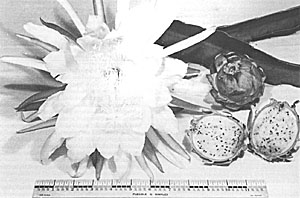From the book
Fruits of Warm Climates
by Julia F. Morton
Strawberry Pear
Hylocereus undatus Britt. & Rose
Cereus undatus Haw.
CACTACEAE
This is one of the most beautiful and widespread members of the family
Cactaceae, with one common name for its fruit, strawberry pear, and
another for the plant, night-blooming cereus. Hylocereus undatus Britt. & Rose (syn. Cereus undatus Haw.), has been often misnamed H. triangularis, a binomial restricted today to a very similar cactus, H. triangularis Britt. & Rose (syns. Cereus triangularis Haw.; Cactus triangularis L.), endemic in Jamaica.
The
Spanish terms pitaya, pitajaya, pitahaya, are applied to the strawberry
pear in Latin America, in common with the edible fruits of several
other species of cacti; but pitahqya roja and pitahaya blanca are
applied specifically to H. undatus in Mexico; pitahaya de cardón
in Guatemala.

Fig. 96: The strawberry pear is the fruit of the much-admired climbing cactus (Hylocereus undatus), one of several species called "night-blooming cereus".
Description
This
cactus may be terrestrial or epiphytic. Its heavy, 3-sided, green,
fleshy, much-branched stems with flat, wavy wings having horny margins,
may reach 20 ft (6 m) in length. They arch over rocks or bushes, climb
and form dense masses in trees, and cling to walls, by means of
numerous, strong aerial roots. There are 2 to 5 short, sharp spines at
each areole. The magnificent, night-blooming, very fragrant,
bell-shaped, white flowers, up to 14 in (35 cm) long and 9 in (22.5 cm)
wide, have a thick tube bearing several linear, green scales 1 1/2 to 3
in (4-7.5 cm) long, above which is a circle of recurved,
greenish-yellow, linear segments 4 3/8 in (11 cm) long and 3/8 to 5/8
in (1-1.6 cm) wide, and an inner circle of about 20 white,
oblong-lanceolate segments 4 in (10 cm) long and 1 1/4 to l 1/2 in
(3.2-4 cm) wide. Very numerous, cream-colored stamens form a showy
fringe in the center and at the apex of the thick perianth tube. The
non-spiny fruit is oblong-oval, to 4 in (10 cm) long, 2 1/2 in (6.25
cm) thick, coated with the bright-red, fleshy or yellow, ovate bases of
scales. Within is white, juicy, sweet pulp containing innumerable tiny
black, partly hollow seeds.
Origin and Distribution
The
strawberry pear is believed native to southern Mexico, the Pacific side
of Guatemala and Costa Rica, and El Salvador. It is commonly cultivated
and naturalized throughout tropical American lowlands, the West Indies,
the Bahamas, Bermuda, southern Florida and the tropics of the Old World.
Degener
tells how this species reached Hawaii in 1830 in a shipment of plants
loaded at a Mexican port aboard a ship en route from Boston to Canton,
China. He says most of the plants died and were being discarded during
a stopover in Hawaii, but the Captain noticed that the strawberry pear
was still partly alive. Cuttings were planted and flourished and the
cactus became a common ornamental in the islands. It blooms there
spectacularly but rarely sets fruit. This species is often used as a
rootstock on which to graft various ornamental cacti including
Zygocactus, Epiphyllum and Rhipsalis.
It blooms and fruits mainly in August and September.
Varieties
It is not clear whether the pitahaya amarilla of Colombia is the same as the yellow form of H. undatus which occurs in Mexico. Perez-Arbelaez describes it under Cereus triangularis
Haw. but expresses doubt as to its true identity. The attractive and
delicious fruit is served whole or halved as dessert in hotels in
Bogotá. (see Plate XLVIII).
Food Uses
The
ripe strawberry pear is much appreciated, especially if chilled and cut
in half so that the flesh can be eaten with a spoon. The juice is
enjoyed as a cool drink. A sirup made of the whole fruit is used to
color pastries and candy. The unopened flowerbud can be cooked and
eaten as a vegetable.
Food Value
We
have only Aguilar Giron's assay of the pulp: water, 92.20; protein,
0.48-0.50; carbohydrates, 4.33-4.98; fat, 0.17-0.18; fiber, 1.12; ash,
1.10%.
Analyses made in Guatemala were published under the heading "Hylocereus undatus".
However, the pulp is described in accompanying notes as being "a
bright, clear cerise", and the fruits analyzed were accordingly those
of H. guatemalensis Britt. & Rose which is very much like H. undatus,
but has smaller, red-fleshed fruits instead of white-fleshed. A large
vine of the Guatemalan species has festooned a tree at the Agricultural
Research and Education Center, Homestead, Florida, for many years. The
composition of this species, analyzed by Munsell, et al. (1950), is
tabulated here in lieu of comparable data on H. undatus.
| Food
Value Per
100 g of Edible Portion* |
| Moisture |
82.5-83.0 g |
| Protein |
0.159-0.229 g |
| Fat |
0.21-0.61 g |
| Crude Fiber |
0.7-0.9 g |
| Ash |
0.54-0.68 g |
| Calcium |
6.3-8.8 mg |
| Phosphorus |
30.2-36.1 mg |
| Iron |
0.55-0.65 mg |
| Carotene |
0.005-0.012 mg |
| Thiamine |
0.28-0.043 mg |
| Riboflavin |
0.043-0.045 mg |
| Niacin |
0.297-0.430 mg |
| Ascorbic Acid |
8.0-9.0 mg |
*Analyses of H. guatemalensis. |
|
Medicinal Uses
The sap of the stems of H. undatus
has been utilized as a vermifuge but it is said to be caustic and
hazardous. The air-dried, powdered stems contain B-sitosterol.
Related Species
H. ocamponis Britt. & Rose (syn. Cereus ocamponis
Salm-Dyck) is a similar cactus cultivated in Guatemala, Colombia,
Bolivia and Puerto Rico. It has more deeply undulate wings bordered
with brown, and longer spines. The fruit is wine-red outside and inside
and the pulp is sweet.
The so-called apple cactus is Cereus Peruvianus
Mill., a striking, large, erect, multiple-stemmed, ribbed, spiny
columnar species from South America, much grown as an ornamental in
southern Florida and Hawaii. The fruit is oval, to 4 in (10 cm) long,
deep-pink externally and white internally, sweet, juicy and desirable.
|
|